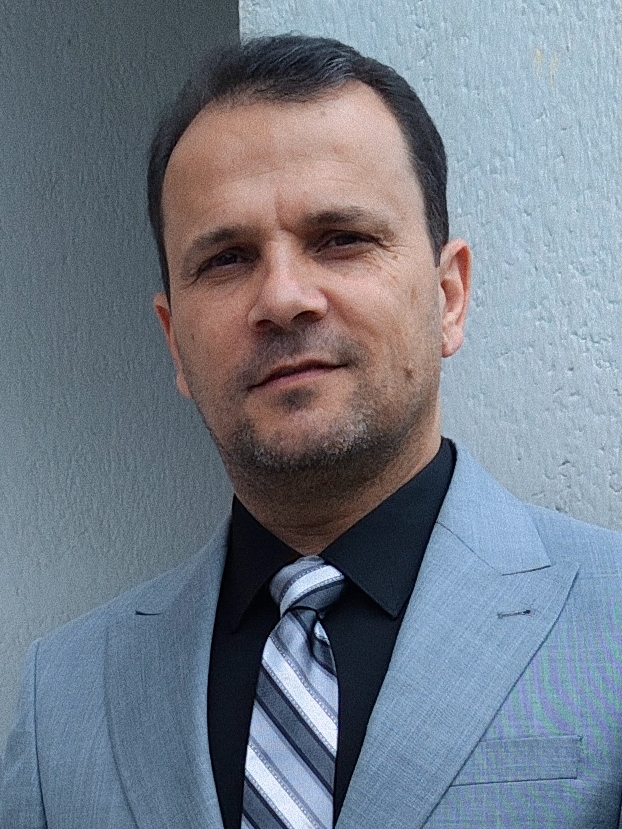
Raid Waadullah Daoud
Research InterestsArtificial Intellegence
Optimization
Neural Networks
Computer Networks
Optical Fiber
Classification
Remote Monitor and Control (IoT)
| Gender | MALE |
|---|---|
| Place of Work | Hawija Technical College |
| Position | Assistant Dean for Scientific Affairs |
| Qualification | Master |
| Speciality | Computer Engineering and Artificial intelligence |
| raid_hwj@ntu.edu.iq | |
| Phone | 07710732184 |
| Address | Mosul, Mosul, Mosul, Iraq |

Raid W. Daoud holds a Bachelor's degree in Computer Engineering (2003) and a Master's degree (2008) from the Technical Engineering College, Mosul. With over 45 published research papers in various scientific fields, he specializes in Digital Control and Optimization Processes. Currently, he serves as a lecturer, teaching postgraduate courses in Robotics and AI, while actively researching innovative solutions to complex engineering challenges.
60 +
Internet Service
75 +
Computer Network Lab
Languages
Second Language (70%)
Second Language (70%)
Second Language (72%)
Second Language (75%)
Skills
Computer Network (Design and Optimization) (85%)
Artificial Intellegence (75%)
Artificial Neural Network (Classification, Prediction and Decision Making)) (90%)
Wireless Sensor and Fault prediction (80%)
Microcontroller (Design and Programming) (80%)
Supervision
Ayat W. Mahmood
Year: 2025Academic Degree: Master
Supervisor Type: Co-supervisor
Supervisor State: In Progress
A Comprehensive Review of IoT-based Monitoring and Fault Prediction in Photovoltaic Systems
Academic Qualification
Bachelor's
Nov 1, 1999 - Oct 1, 2003Computer Engineering Techniques
Master
Nov 1, 2005 - Aug 20, 2008Computer Engineering Techniques
Assistant Professor
Jan 8, 2023 - PresentSpecialist in Artificial Intelligence and Digital Control
Working Experience
Labs, Networks, Internet and Exams [Computer Center Adminstrator]
Mar 1, 2012 - Jun 9, 2014Students Adminstration [Head of Department Assistant]
Sep 1, 2018 - Aug 31, 2019Electrical Techniques Dept. [Head of Department]
Sep 1, 2019 - Sep 15, 2020Hawija Technical Institute [Assistant Dean for Scientific Affairs]
Mar 1, 2021 - Sep 1, 2022Hawija Technical College [Assistant Dean for Scientific Affairs]
Sep 1, 2023 - PresentPublications
A study of voltage regulation in microgrid using a DSTATCOM
Oct 1, 2020Journal Bulletin of Electrical Engineering and Informatics (BEEI)
publisher Institute of Advanced Engineering and Science (IAES)
DOI https://doi.org/10.11591/eei.v9i5.2442
Issue 9
Volume 5
A well-prepared abstract enables the reader to identify the basic content. This paper presents the solution of voltage fluctuations in urgent situations by providing voltage and reactive support from a distribution static synchronous compensator (DSTATCOM) in the grid. Also, it analyses the influences of DSTATCOM as a voltage controller and compares the system performance with and without DSTATCOM. The DSTATCOM is used in the study to maintain voltage in the microgrid (MG) to be around the rated value after Microgrid disturbance. A successful simulink model of the photovoltaic (PV) system and the proposed DSTATCOM are illustrated to work together as the Microgrid. Microgrids could provide unique resilience and reliability when the environment encountered with less water, higher temperatures, more frequent and harsh wildfires, and severe weather events. The proposed DSTATCOM was installed in different locations in the MG and the best location was chosen to achieve the goal of improved power quality and efficiency. In this paper, two scenarios are discussed with and without DSTATCOM. The simulation results show the difference between the MG with and without DSTATCOM and how the DSTATCOM can amplify power quality in the Microgrid. The proposed DSTATCOM has the capability to improve dampen power oscillations during transit events.
Photovoltaic storage solar collector: Experimental assessment
Nov 11, 2022Journal Energy Reports
publisher Elsevier
DOI https://doi.org/10.1016/j.egyr.2022.10.126
Issue 8
This article introduces a new design of solar storage collectors integrated with a PV panel for domestic applications. Two identical practical models were built to test the performance of the collectors by analyzing and comparing them with the classical storage solar collector. In the first model, the solar cells were mounted on the tank’s front inclined surface to act as a black absorber surface, while in the second model, the absorbent plate was metallic and dyed in a pale black color. A number of experiments have been conducted on both models to validate and assess their performance. For the no-load conditions, the maximum storage temperature was about 77 °C and 81 °C for the new and conventional models respectively. For the load conditions, the mean storage temperature recorded the maximum value of 77 °C and 74 °C for the new model and conventional models respectively. Electrical efficiency increased as a result of removing warm water from the model. The highest electrical efficiency recorded for the new system was 15% at 9 a.m., with a water flow rate of 0.085 liters/min. On the other hand, the thermal efficiency of the new system is lower than the traditional system. The highest thermal efficiency recorded for the new system was 69% at 10 a.m., with a water flow rate of 0.085 liters/min. At the same time, the highest thermal efficiency for the conventional system was 88% at 11 a.m., with a water flow rate of 0.085 liters/min. It was also found that increasing the mass flow of the fluid drawn from the collector increases the thermal efficiency of the old and new designs.
Performance improvement of photovoltaic/Trombe wall by using phase change material: Experimental assessment
Nov 15, 2022Journal Journal of Energy Storage
publisher Elsevier
DOI https://doi.org/10.1016/j.est.2022.105596
Issue 55
Volume B
Hybrid PV/thermal systems suffer from reduced electrical performance due to high temperatures. The present study uses a phase change material (PCM) to optimize the performance of a PV/TW system. In this research, an empirical system was designed and utilized to study the impact of PCM, DC fan, and heat exchange on a photovoltaic Trombe wall system. The outcomes showed that by introducing the phase change material, a DC fan and heat exchanger presented appropriate features of the system performance. It was confirmed that using these different configurations led to a lower solar cell temperature and improved room comfort. The presence of the PCM and the heat exchanger together caused the electrical and thermal efficiency values to rise by 3 % and 1.5 %, respectively. Moreover, the combined impact of the DC fan and the heat exchanger together increased electrical and thermal efficiencies values by 1 % and 26 %, respectively.
Arduino-based design and implementation of experimental rooms with a trombe wall for solar cells applications
Apr 10, 2023Journal Bulletin of Electrical Engineering and Informatics (BEEI)
publisher Institute of Advanced Engineering and Science (IAES)
DOI https://doi.org/10.11591/eei.v12i3.4522
Issue 12
Volume 2
The simplicity of design and construction following the researcher's or company's notion is the most typical description of solar panels. There will be a set of sensors in every design to derive information about the environment's shifting seasons and days. Two chambers of 1 m2 and 2 m in height were constructed for this study. A solar panel made from a unique exchangeable material has been installed instead of one of the walls, allowing a space between them for experimental reasons. Several temperature sensors were mounted inside and outside the chamber, as well as on the surface of the solar panel and within the air openings, in this work to record the temperature readings in various places. The used controller, an Arduino, is in charge of several operations, including controlling the solar panel's cooling device, reading and recording sensor data and storing it in RAM, controlling the orientation of the solar panel, controlling the vacuums, and regulating the on-off time of the motors. The findings show that by using sensor data, the system can keep the temperature constant when it is turned on. Additionally, the battery life will be preserved to the greatest extent feasible thanks to the well-balanced regulation of the loads.
Design of Power Control Circuit for Grid-Connected PV System-Based Neural Network
Apr 23, 2024Journal Journal of Robotics and Control (JRC)
publisher Department of Electrical Engineering, Universitas Muhammadiyah Yogyakarta
DOI https://doi.org/10.18196/jrc.v5i3.20751
Issue 5
Volume 3
This research explores the application of neural networks in managing grid- photovoltaic (PV) systems. this paper aims to improve the performance and reliability of PV systems using artificial intelligence capabilities, specifically neural networks. The main emphasis of this system is to control active and reactive power and to track the maximum power point (MPPT). This study introduces an intelligent control technique for fuel cell distributed generation (DG) grid connection inverters. The algorithm allows for the management of both active and reactive power for the unit. The algorithm provides local reactive power compensation, making it economically viable. The controller modeling and performance validation are conducted using MATLAB/Simulink and Sim power system blocks, demonstrating its capacity for enhancing power factor. This makes fuel cell technology a clean, highly controllable, and economically viable option for DG systems. The system maximizes the energy extraction of PV panels and maintains them at their ideal PowerPoint across various environmental conditions. It also raises the voltage from 260 volts to 350 volts. Simulations and practical evaluations validate the proposed control system. The obtained results indicate that the total harmonic distortion (THD) of the grid current under operating conditions was less than 1.86%. This demonstrates significant improvements in the efficiency and reliability of PV systems. The neural network controller shows remarkable flexibility and the ability to quickly adapt to fluctuations in load and radiation, which contributes to developing a more sustainable and stable energy network.
The effect of operating conditions and climate change on the performance of the photopholtaic Trombe wall: An empirical estimate
Sep 10, 2024Journal Journal of Thermal Engineering
publisher Yildiz Technical University
Issue 10
Volume 5
Due to its significance and effect on interior spaces, photovoltaic Trombe walls are regarded as sustainable technologies. This is because they use solar energy to heat the building and give thermic comfort without requiring the use of cooling equipment to reduce power consumption. not to mention supplying the structure with electricity. To investigate how operational conditions and climatic change affect PV/TW, two empirical models—one with DC fans and the other without—were developed. The two models were compared with each other. To demonstrate their impact on system competency, operating conditions for both dusty and non-dusty days have been examined. When DC fans are used on a dust-free day, the system’s electrical and thermal competence is 10.2 percent and 17.6 percent, respectively. The system’s electrical and thermal competence levels were 8.4 percent and 40.1 percent, respectively, on a day when there was no dust and when the DC fans were not operating. The system that had fans had a higher thermic and electrical efficiency than the other two systems, with values of 11.9 percent and 6.6 percent, respectively, on the dusty days. The system’s thermic and electrical efficiency were 34.1 percent and 3.5 percent, respectively, without fans. This suggests that dusty days have an impact on the experimental system’s electrical and thermic efficiency.
Estimation of wind speed by artificial intelligence method: A case study
Sep 10, 2024Journal Journal of Thermal Engineering
publisher Yildiz Technical University
Issue 10
Volume 5
Wind speed changes from one region to another due to several influencing variables. In this article, a software method has been proposed to determine the future wind speed at any time and under any conditions. Neural Networks were used with engineering data regarding the method of education, training algorithms, and different activation functions between the input and output layers, each according to the nature of the data that would be generated. Back-propagation Neural was used with three variables chosen to be the inputs for the learning and training network (wind speed, humidity, and time), which are considered the most important in determining the proposed or expected speed at the relevant time and place. The hidden layer consists of 10 neurons, which are determined according to the precision of output. After comparing the measurements from the weather system with the expected values, a very tiny percentage of error was found since these readings are regarded as acceptable and aid in the problem-solving process for running companies and researchers. The error rate recorded in this work ranged between (3 * 10-3 and 3 * 10-5), and the average number of attempts for the training and examination process reached 33 attempts, as it is known that neural networks carry out the training process based on specific mathematical functions and closed loops that depend on the lowest possible error rate.
Conferences
A Comparison Study of PV/Thermal Collector Performance Using Air and Water Cooling
Oct 6, 2021 - Oct 7, 2021Publisher AIP Conference Proceedings
DOI https://doi.org/10.1063/5.0124223
Country Iraq
Location Iraq
Exergy and Energy Analyses of 70 Mw Gas Turbine Power Plant Using Fuzzy Logic Control
Oct 27, 2021 - Oct 28, 2021Publisher IEEE
DOI https://doi.org/10.1109/ICEET53442.2021.9659610
Country Iraq
Location Iraq
Fuzzy Based Control of Optimized Efficiency PV Array Power Production
May 11, 2022 - May 12, 2022Publisher AIP Conference Proceedings
DOI https://doi.org/10.1063/5.0182715
Country Iraq
Location Iraq
Recent Enhancement Techniques in the Solar Still: A Comprehensive Review
May 11, 2022 - May 12, 2022Publisher AIP Conference Proceedings
DOI https://doi.org/10.1063/5.0181424
Country Iraq
Location Iraq
Improvement of Protection Factor for a Controlled Laboratory Computer Network Using Artificial Intelligence
Jun 21, 2023 - Jun 22, 2023Publisher IEEE
DOI https://doi.org/10.1109/ICESAT58213.2023.10347302
Country Iraq
Location Iraq








